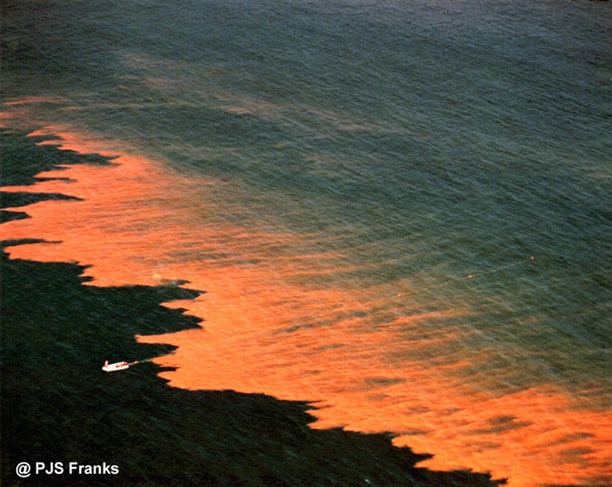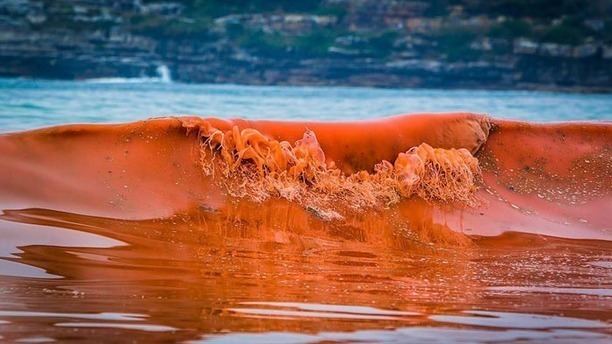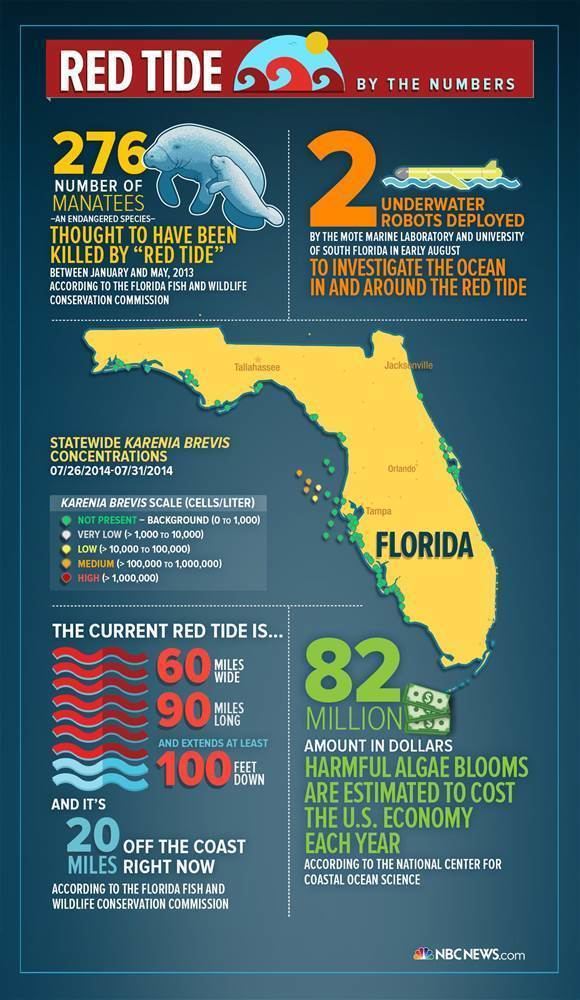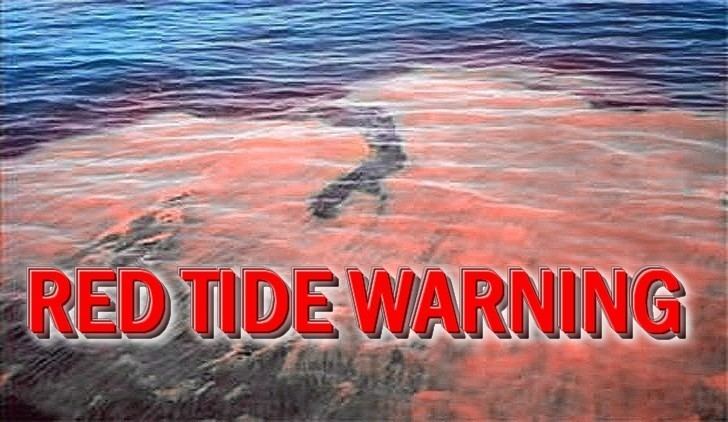 | ||
Red tide toxic algae crisis is worst ever recorded in chile tomonews
Red tide is a common name for a phenomenon known as an algal bloom (large concentrations of aquatic microorganisms) when it is caused by a few species of dinoflagellates and the bloom takes on a red or brown color. Red tides are events in which estuarine, marine, or fresh water algae accumulate rapidly in the water column, resulting in coloration of the surface water. It is usually found in coastal areas. It kills many manatees every year.
Contents
- Red tide toxic algae crisis is worst ever recorded in chile tomonews
- Should we fear red tides
- Overview
- Definition
- Causes
- Toxins
- Human health effects
- Notable occurrences
- References

These algae, a form of phytoplankton, are single-celled protists, plant-like organisms that can form dense, visible patches near the water's surface.

Certain species of phytoplankton, dinoflagellates, contain photosynthetic pigments that vary in color from green to brown to red. When the algae are present in high concentrations, the water appears to be discolored or murky, varying in color from purple to almost pink, normally being red or green. Not all algal blooms are dense enough to cause water discoloration, and not all discolored waters associated with algal blooms are red. Additionally, red tides are not typically associated with tidal movement of water, hence the preference among scientists to use the term algal bloom.

Some red tides are associated with the production of natural toxins, depletion of dissolved oxygen or other harmful effects, and are generally described as harmful algal blooms. The most conspicuous effects of these kinds of red tides are the associated wildlife mortalities of marine and coastal species of fish, birds, marine mammals, and other organisms.

Should we fear red tides
Overview

Red tides in the Gulf of Mexico are a result of high concentrations of Karenia brevis, a microscopic marine algae that occurs naturally but normally in lower concentrations. In high concentrations, its toxin paralyzes the central nervous system of fish so they cannot breathe. Dead fish have been observed to wash up on gulf beaches of Mexico and Texas. In addition to killing fish and contaminating shellfish, the toxins released by Karenia brevis blooms can kill marine animals including dolphins and manatees. Red tide is very harmful to the environment and ocean inhabitants, because toxins produced by it can affect the central nervous systems of fish, birds, mammals, and other animals. Dense concentrations appear as discolored water, often reddish in color. It is a natural phenomenon, but the exact cause or combination of factors that result in a red tide outbreak are unknown. Red tide causes economic harm and for this reason red tide outbreaks are carefully monitored. For example, the Florida Fish and Wildlife Conservation Commission provides an up-to-date status report on the red tide in Florida. Texas also provides a current status report.
Red tides also occur regularly in the Coral Sea, Torres Strait, and along the south coast of Papua New Guinea. The intensities observed are much lower than those found on the Chilean coast, and often go unnoticed. Only two deaths, occurring in April 1972, have ever been confirmed. The closely related ciguatera fatal poisoning is, however, found across large areas of the Western Pacific. While there is no one particular cause of red tides, there are many different factors that contribute to its presence. These factors can include things such a water and coastal pollution which originates from sources such as human sewage and agricultural runoff. There are other factors that have been associated with the increase in red tides, such as weather and tidal patterns, although the correlation isn't always quite clear.
Red tide is also potentially harmful to human health. Humans can become seriously ill from eating oysters and other shellfish contaminated with red tide toxins. "In general, bivalves will contain much larger amounts of toxin compared to univalves. Symptoms are very similar to the those found in the closely related ciguatera poisoning." Shellfish consume the organisms responsible for red tide and concentrate saxitoxin (produced from these organisms) in their tissues. Saxitoxin blocks sodium channels and ingestion can cause paralysis within 30 minutes. Karenia brevis blooms can potentially cause eye and respiratory irritation (coughing, sneezing, tear production, and itching) to beachgoers, boaters and coastal residents. People with severe or persistent respiratory conditions (such as chronic lung disease or asthma) may experience stronger adverse reactions. The National Oceanic and Atmospheric Administration's National Ocean Service provides a public conditions report identifying possible respiratory irritation impacts in areas affected by red tides.
There is debate over the cause of red tides. Red tides occur naturally off coasts all over the world. Not all red tides have toxins or are harmful.
Definition
Red tide is a colloquial term used to refer to one of a variety of natural phenomena known as harmful algal blooms or HABs. The term red tide specifically refers to blooms of a species of dinoflagellate known as Karenia brevis. It is sometimes used to refer more broadly to other types of algal blooms as well. K. brevis produces a potent neurotoxin, known as the brevetoxin (i.e. PbTx or Ptychodiscus toxins), which can cause illness and mortalities in fish, seabirds, and marine mammals. Humans are susceptible to the effects of exposure to brevetoxins as well, as public health surveillance has documented human intoxication from eating seafood that is contaminated or respiratory complaints from inhaling contaminated aerosols.
The term red tide is being phased out among researchers for the following reasons:
- Red tides are not necessarily red and many have no discoloration at all.
- They are unrelated to movements of the tides.
- The term is imprecisely used to refer to a wide variety of algal species that are known as bloom-formers.
As a technical term it is being replaced in favour of more precise terminology including the generic term harmful algal bloom for harmful species, and algal bloom for non-harmful species.
The term red tide is most often used in the United States of America to refer to Karenia brevis blooms in the eastern Gulf of Mexico, also called the Florida red tide. In the past decade, it has been elucidated that K. brevis is only one of many different species of the Genus, Karenia, that is found in the world's oceans. There have been major advances in the study of dinoflagellates and their genomics. Some include identification of the toxin-producing genes (PKS genes), exploration of impacts environmental changes (temperature, light/dark, etc.) have on gene expression, as well as an appreciation of the complexity of the Karenia genome. These blooms have been documented since the 1800s and occur almost annually along Florida waters. There was increased research activity of HABs in the 1980s and 1990s. This was primarily driven by media attention from the discovery of new HAB organisms and the potential adverse health impacts of their exposure to animals and humans. Recently, the Florida red tides have been observed to have spread as far as the eastern coast of Mexico. The density of these organisms during a bloom can exceed tens of millions of cells per litre of seawater, and often discolor the water a deep reddish-brown hue.
The term red tide is also sometimes used to describe harmful algal blooms on the northern east coast of the United States, particularly in the Gulf of Maine. This type of bloom is caused by another species of dinoflagellate known as Alexandrium fundyense. These blooms of organisms cause severe disruptions in fisheries of these waters as the toxins in these organism cause filter-feeding shellfish in affected waters to become poisonous for human consumption due to saxitoxin. The related Alexandrium monilatum is found in subtropical or tropical shallow seas and estuaries in the western Atlantic Ocean, the Caribbean Sea, the Gulf of Mexico and the eastern Pacific Ocean.
Causes
The occurrence of red tides in some locations appears to be entirely natural (algal blooms are a seasonal occurrence resulting from coastal upwelling, a natural result of the movement of certain ocean currents) while in others they appear to be a result of increased nutrient loading from human activities. The growth of marine phytoplankton is generally limited by the availability of nitrates and phosphates, which can be abundant in agricultural run-off as well as coastal upwelling zones. Coastal water pollution produced by humans and systematic increase in sea water temperature have also been implicated as contributing factors in red tides. Other factors such as iron-rich dust influx from large desert areas such as the Saharan desert are thought to play a major role in causing red tides. Some algal blooms on the Pacific coast have also been linked to occurrences of large-scale climatic oscillations such as El Niño events. While red tides in the Gulf of Mexico have been occurring since the time of early explorers such as Cabeza de Vaca, it is unclear what initiates these blooms and how large a role anthropogenic and natural factors play in their development. It is also debated whether the apparent increase in frequency and severity of algal blooms in various parts of the world is in fact a real increase or is due to increased observation effort and advances in species identification methods.
While the human contribution to the long-term increase in red tides is apparent, some researchers propose that climate change is also a factor, with more research still needed to be done in order to claim it as a definitive causal relationship. Increasing temperature, enhanced surface stratification, alteration of ocean currents, intensification or weakening of local nutrient upwelling, stimulation of photosynthesis by elevated CO2, reduced calcification through ocean acidification, and heavy precipitation and storm events causing changes in land runoff and micronutrient availability may all produce contradictory species- or even strain-specific responses. In terms of Harmful Algal Blooms (HABs), we can expect: (i) range expansion of warm-water species at the expense of cold-water species, which are driven poleward; (ii) species-specific changes in the abundance and seasonal window of growth of HAB taxa; (iii) earlier timing of peak production of some phytoplankton; and (iv) secondary effects for marine food webs, notably when individual zooplankton and fish grazers are differentially impacted by climate change. However, the potential consequences of these changes for HABs have received relatively little attention and are not well understood. Substantial research is needed to evaluate the direct and indirect associations between HABs, climate change, ocean acidification, and human health.
Toxins
K. brevis blooms produce powerful natural neurotoxins known as brevetoxins. The brevetoxins bind to voltage-gated sodium channels, an important structure of cell membranes. Binding results in persistent activation of nerve cells, which interferes with neural transmission leading to health problems. These toxins are created within the unicellular organism, or as a metabolic product.
There are two major types of brevetoxin compounds with similar but distinct backbone structures. PbTx-2 is the primary intracellular brevetoxin produced by K. brevis blooms. However, overtime the PbTx-2 brevetoxin can be converted to PbTx-3 through metabolic changes.
Humans can inhale aerosolized brevetoxins. Brevetoxins become aerosolized by bubble-mediated transport of extracellular toxins. Through this process, bubbles transport the toxins to the water's surface, as the bubbles rupture they release the toxins into the air. The wind can then sweep these toxins toward shore, onto the beaches and into the communities where they can be inhaled by humans.
Human health effects
Neurotoxic shellfish poisoning (NSP) is caused by the consumption of shellfish contaminated by brevetoxins which are produced by the dinoflagellate, Karenia brevis. There are often both gastrointestinal and neurological symptoms of NSP including diarrhea, nausea/vomiting, numbness or tingling in lips face or extremities, disorientation, and partial paralysis. For public safety, NSP in shellfish is monitored by the State of Florida. There have been no new deaths attributed to NSP. Occasional new cases of NSP may occur when people consume unregulated shellfish species, when shellfish are illegally harvested, or when blooms expand to unmonitored geographic areas. There have been recent discoveries of Planktivorous finfish that retain the toxins in their muscles and organs,especially the liver. However, these toxins occur in finfish at much lower concentrations than shellfish
The toxins of K. brevis can also become aerosolized by surf, winds, or breaking waves. The inhalation of aerosolized K. brevis red-tide toxins may result in conjunctival irritation, runny nose, nonproductive cough, and wheezing. In healthy individuals, there seems to be a rapid reversal of these symptoms by leaving beach areas or entering an air-conditioned area. However, persons with severe asthma appear to be more susceptible to K brevis red-tide toxins. It has been shown that these individuals report a decrease in respiratory function after only 1 hour of exposure to a K brevis red-tide beach and these symptoms may last for days.
